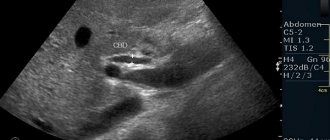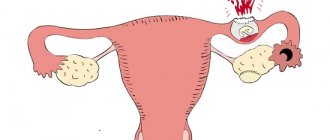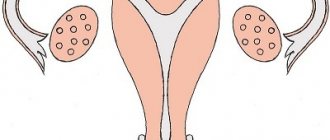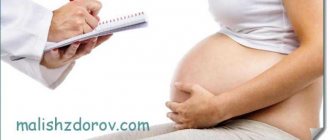What is whooping cough
Whooping cough is a disease that is bacterial in nature.
Its causative agent is the Bordet-Gengou bacterium. You can become infected with whooping cough through contact with a sick person. The main route of transmission of infection is airborne droplets. The main distinguishing feature of the disease is a severe cough, which is spasmodic in nature. A person does not have innate immunity to this disease, and antibodies are not transmitted through mother's breast milk.
After a person has had whooping cough, an acquired form of immune response is formed, which persists throughout life.
Currently, vaccination against whooping cough is included in the list of mandatory vaccinations, because the disease is very dangerous for young children.
During pregnancy, whooping cough also has a number of negative consequences for both the woman and the child. Therefore, it is very important to protect yourself from infection with this pathogen.
How can you get infected?
The activity of a woman's immune system decreases significantly with the onset of pregnancy. Therefore, the body becomes more susceptible to various pathogens.
Immunity to this disease can only be formed through vaccination or if you had to suffer from the disease.
It is believed that protection lasts throughout life. In practice, antibodies remain in the body for a maximum of 20 years. And even if they are present, the possibility of infection cannot be excluded.
Whooping cough is transmitted by airborne droplets through contact with a sick person. A short conversation is enough for infection. After conception, a woman is advised to reduce her visits to places with large crowds of people.
At the first suspicious symptoms, you should immediately consult a doctor, because... Whooping cough in pregnant women has an extremely negative effect on the fetus.
What is parawhooping cough during pregnancy?
Parapertussis can occur in three forms. With the atypical form, there are no coughing attacks, the disease does not progress through successive stages. In the whooping cough form of the disease, the cough will be paroxysmal. If a person is a carrier of the whooping cough bacterium, then he will not have symptoms of the disease.
How to treat a sore throat during pregnancy: 4 symptoms of disease
Before a pregnant woman goes to the antenatal clinic, she should also visit her gynecologist. Treatment is carried out at home.
Treatment of parawhooping cough:
- Long-term exposure to fresh air, as the disease is characterized by a lack of oxygen;
- Some inhaled mucolytics are allowed;
- A diet is prescribed that excludes foods that can cause irritation of the throat mucosa;
- Vitamin therapy is also prescribed.
The doctor will prescribe antibiotics if complications develop - inflammation of the bronchi or lungs. The daily regimen during illness should be gentle, no physical activity or overwork. The main thing is that the course of the disease and its prognosis are favorable for the expectant mother. If you have a severe cough, ailment, or fever, a pregnant woman should not go to the doctor herself, especially since the disease is dangerous for others. Call a doctor at home.
Causes
The causative agent of this disease is the rod-shaped bacterium Bordet-Gengou. After contact with a sick person, it enters the respiratory tract, where it begins to actively multiply.
Getting into the bronchial region during its life, the bacterium releases harmful substances - toxins. They are transported through the bloodstream to all parts of the body.
Most often, infection occurs during the cold seasons of the year. This is due to the fact that high temperature is detrimental to bacteria.
Forms of whooping cough:
- typical – the disease is acute, the symptoms are well expressed;
- atypical – symptoms are not pronounced, there is no typical cough;
- the carrier - the woman is not sick, but only carries a pathogenic bacterium.
The duration of the disease is about a month. Throughout this period, the woman is contagious to others, so it is necessary to reduce the frequency of contact with her.
Catarrhal period
The spasmodic period lasts from 4 to 6 weeks. A strong paroxysmal cough appears, which makes it possible to distinguish whooping cough from other diseases. A coughing attack with whooping cough consists of strong coughing impulses, coming one after another. After several coughing shocks, a whistling deep breath occurs (reprise). The attack ends with the discharge of thick and very viscous sputum. It is possible to develop vomiting at the height of a coughing attack.
The number of coughing attacks during the day varies from 5 to 40 or more. Most often, attacks occur in the evening and at night. During coughing, short-term cessation of breathing (apnea) is possible. The general condition of the woman is not affected. Body temperature at this stage of the disease remains within normal limits.
Recovery from whooping cough is long and takes at least 2-4 weeks. During this period, coughing attacks become less and less frequent and then disappear completely. A normal cough with a small amount of sputum persists for 2-3 weeks. The pregnant woman's condition is gradually improving.
The whooping cough vaccine does not guarantee complete protection against this disease. In 5% of people, infection occurs even after vaccination. After vaccination, the disease proceeds atypically and is not always accompanied by the appearance of coughing attacks with recurring episodes and apnea. In this regard, diagnosing whooping cough in adults (including pregnant women) is very difficult. In case of an atypical course of the disease, a diagnosis can be made only after a targeted laboratory examination.
At the initial stage, the cough is dry and moderate. Over time, the cough intensifies and becomes more intrusive. Coughing attacks occur mainly in the evening or at night. The woman's general condition remains satisfactory. A slight increase in body temperature to 37-37.5° C is possible. The duration of this stage of the disease is 7-14 days.
In the catarrhal period, it is almost impossible to distinguish whooping cough from another respiratory disease. In this case, the patient already becomes infectious to others. Whooping cough bacteria are shed by coughing and sneezing during the first three weeks of illness.
Symptoms
Depending on the stage of the disease, symptoms change and intensify. They are becoming more and more pronounced.
For the first 14 days, the disease is in the incubation phase. There are no symptoms at this stage. The woman does not yet suspect that she is infected.
Some people may develop a cough for 7 days. It appears at night. The type of cough is dry. Against the background of this symptom, there may be a slight increase in body temperature.
2 weeks after infection, symptoms become more pronounced. The cough recurs in frequent and severe attacks. It still appears at night and can provoke a short-term respiratory arrest in the expectant mother.
After 21 days, symptoms begin to gradually decrease. At this stage, the production of immune system antibodies occurs.
The appearance of a slight fever and dry cough is a reason for a pregnant woman to sound the alarm. These symptoms should definitely alert you and prompt a visit to the doctor.
The causative agent of the disease
Among the pronounced symptoms of whooping cough are:
- swollen lymph nodes;
- the appearance of a slight cough at the beginning of the disease, which over time develops into a very severe cough with the release of glassy viscous sputum;
- temperature increase;
- inflammation of the nasal mucosa;
- the appearance of a rash that spreads throughout the body in two or three hours (small oval or round pale pink spots).
Signs of whooping cough can be easily confused with the onset of ARVI: fever, cough and general weakness.
It is worth noting that with whooping cough, the cough is very specific; it is protracted, barking, and can sometimes cause vomiting, nosebleeds, swelling of the veins in the neck, and can even end in temporary cessation of breathing.
Signs of whooping cough in adults appear quite quickly, and coughing attacks usually repeat from five to fifty times a day.
Diagnostics cannot always detect whooping cough, since often the pathogen cannot be detected in the infected body.
The fact is that the whooping cough bacillus lives from one to three weeks, and the incubation period can be prolonged, so at the time of the active development of the disease there may no longer be a pathogen in the body.
The most effective diagnostic method is a blood test for whooping cough, which is a pharyngeal culture of mucus.
The disease develops gradually, its incubation period ranges from 2 to 13 days. The disease itself is characterized by the following symptoms:
- enlarged lymph nodes;
- the appearance of a slight cough, gradually turning into a strong one, in the form of a spasmodic attack, with the release of thick sputum;
- increased temperature;
- the occurrence of a runny nose;
- the appearance of pink rashes on the face (subsequently there are no scars or pigmentation left).
The disease is caused by a special microorganism - the bacterium Bordetella pertussis, which is a gram-negative round rod measuring 0.3 * 1 microns. It is capable of producing heat-stable toxins, lecithinase, hyaluronidase, and plasmacoagulase. On its surface it carries somatic O and capsular antigens, in response to which stable lifelong immunity is formed.
Bordetella is not resistant to the environment and, when exposed to sunlight, loses its pathogenic properties within 1 hour. When heated above 55 degrees, the causative agent of whooping cough dies in 15 minutes, in a 3% phenol solution - instantly.
The incubation period for whooping cough in pregnant women ranges from 2 days to 2 weeks. Then the characteristic symptoms of the disease gradually begin to develop. Whooping cough during pregnancy is severe and is characterized by frequent development of complications for both mother and child. This is due to the fact that many changes occur in the female body during pregnancy and it is difficult for the immune system to resist infection.
The staged course of the disease in expectant mothers is characteristic:
- Catarrhal period. It appears after incubation and is characterized by the appearance of a dry, moderate cough (mainly at night). The temperature rarely rises to 37 degrees, the general condition of the pregnant woman does not suffer. At this stage, it is almost impossible to distinguish dangerous whooping cough from a banal ARVI, which leads to the establishment of a false misdiagnosis and the prescription of incorrect treatment.
- The spasmodic period is characterized by the appearance of severe coughing attacks with reprises characteristic of whooping cough, the release of thick mucous sputum, and fever. An untreated cough greatly exhausts the mother's body, leads to insomnia, anxiety and disruption of the general condition, which has a negative impact on the developing fetus and the course of pregnancy itself. The period of spasmodic cough is the most dangerous for pregnant women and the baby and definitely requires treatment.
- Reversal is a period of gradual extinction of the symptoms of the disease. It is characterized by a decrease in the intensity and frequency of coughing attacks and an improvement in the patient’s condition. However, during this period there remains the possibility of dangerous consequences for the mother and child, so treatment and medical supervision should continue until complete recovery.
Against the background of the typical course of whooping cough, the expectant mother may experience complications such as inflammation of the larynx, bronchi, and severe pneumonia. Bleeding from the nose and encephalopathy with the development of convulsive syndrome are extremely rare.
If whooping cough is suspected, during a preventive examination, gynecologists must refer the pregnant woman to an ENT specialist for consultation. Typical signs that allow diagnosing a dangerous disease at an early stage are swelling of the laryngeal mucosa and hemorrhages, noticeable only during laryngoscopy. The diagnosis is confirmed by serological reactions and PCR.
In order to decide on the prescription of the right medications during pregnancy, it is necessary to diagnose the disease in a timely manner, and once specific coughing attacks develop, this is not at all difficult to do.
To make an accurate diagnosis use:
- Bacterioscopic examination - a sample of mucus from the mouth and nose is examined under a microscope for the presence of microbes.
- Bacteriological examination - inoculation of the same samples is placed in a nutrient medium, where microbes begin to grow, forming colonies. With this diagnostic method, the effect of drugs on bordetella is also determined.
- Enzyme immunoassay is a quick determination of the presence of microorganisms in the mucous membrane of the pharynx and nasopharynx using the “antigen-antibody” reaction, which allows the identification of protein substances.
Did you know? When exposed to the sun, pertussis bacillus loses its properties within 1 hour, and at temperatures above 55 ºС it dies after 15 minutes. A 3% phenol solution kills it instantly.
Diagnostics
This disease is diagnosed by talking with a doctor. To do this, a pregnant woman needs to come to an appointment with a therapist.
Initially, the doctor makes a list of complaints and identifies the symptoms that bother the woman. Then the patient is examined, during which:
- body temperature is measured;
- check for a runny nose;
- using a phonendoscope, the condition of the lungs and heart is listened to;
- The nature of the cough is determined.
After the initial examination, the therapist gives the pregnant woman directions for additional tests and studies:
- throat swab;
- clinical blood test;
- blood test for the presence of antibodies to this pathogen;
- clinical urine analysis.
In addition to visiting a therapist, a woman should consult a gynecologist for advice on the further course of pregnancy.
If the diagnosis of whooping cough has been confirmed, treatment will be required in the infectious diseases department of the hospital.
What kind of disease is this and how is it transmitted?
Whooping cough is an acute bacterial infection, the main symptom of which is coughing attacks accompanied by spasms. The causative agent of the disease is the bacterium Bordetella, which is spread by airborne droplets. The disease occurs in the autumn-winter period, and is very often confused with ARVI, which is accompanied by a prolonged and very debilitating cough. The sensitivity of unvaccinated people to infection is very high - 90%. After infection, the patient remains infectious to others for almost the entire period of the clinical course of the disease.
Did you know?
The first records of whooping cough appeared in 1578 during an epidemic in Paris, and it was only in 1906 that the pertussis bacillus was isolated. In 1942, the first whole-cell DTP vaccine was produced.
Treatment
The treatment regimen for this disease during pregnancy is determined only by a doctor.
To do this, the general condition of the woman’s body is initially analyzed. To draw up a treatment plan, it is necessary to take into account how the pregnancy is progressing, whether there are complications and chronic diseases.
Medicines prescribed for the treatment of whooping cough during the perinatal period:
- mucolytics;
- bronchodilators;
- sedative drugs;
- medicines that dilate blood vessels;
- supporting medications for the fetus (eliminating the risk of hypoxia).
The range of medications depends on the stage of pregnancy at which the infection occurred.
In the first 1.5 months, a pregnant woman is prescribed drugs from the group of antibiotics. They do not have a negative effect on the fetus, but are detrimental to bacteria.
At later stages, the use of antibiotics is undesirable.
If a woman becomes ill with whooping cough in the last trimester, an antibiotic is prescribed to the baby after birth. This is associated with a high risk of intrauterine infection.
Folk remedies
Complex therapy of whooping cough does not exclude the use of traditional medicine. Like any medicine, they should not be taken without consulting a doctor.
Popular folk recipes for whooping cough:
- to reduce the frequency of coughing attacks, you can take calamus with honey;
- infusion of ginger, onion and almond oil juices;
- infusion of anise fruit;
- nettle juice;
- honey-garlic infusion;
- decoction of garlic in milk.
The action of all of these remedies is aimed at reducing the intensity of cough. However, many of the components included in their composition can provoke allergic reactions. Therefore, preliminary consultation with a specialist is mandatory.
How to treat whooping cough in pregnant women
If you have any guesses about the onset of the disease, you should go to the hospital, since only a doctor can correctly assess the condition of a pregnant woman and, taking into account all the risks, prescribe treatment. It can be with the use of both medications and traditional medicine recipes.
If, after taking tests, fears are confirmed and whooping cough is diagnosed, then the doctor prescribes antibiotics:
- Azithromycin;
- Clarithromycin;
- Erythromycin.
In parallel with these drugs, antitussives containing dextromethorphan, for example Grippex, are prescribed. The doctor also recommends all the remedies that are used to treat acute respiratory viral infections during pregnancy. If an infection occurs after more than 28 weeks, a newborn baby is also prescribed a course of antibiotics, since the risk of getting the microbe immediately after birth is very high.
ethnoscience
There are a large number of recipes that are used to treat whooping cough in parallel with medications. But you need to remember that what is suitable for an ordinary patient can be dangerous for a woman who is expecting a baby, therefore, before using any recipe, you must consult with your doctor.
We bring to your attention several recipes:
- Mumiyo - 1 g dissolved in 100 g of warm water. Consume for 10 days 25 minutes before meals once a day.
- Wash a large black radish well, make a hole in the middle part and add 1 teaspoon of honey. Cover the cut with a saucer and place in a warm place overnight. The resulting juice is consumed before meals. Add a spoonful of honey to the radish again, and so on for 15 days, three times a day.
- Take 2 teaspoons of plantain and coltsfoot leaves, 3 teaspoons of pine buds. Grind, pour 3 cups of boiling water and leave for 60 minutes. Take 3 teaspoons three times a day.
- Grate cabbage and beets - 1 cup of mass. Add 2 teaspoons of vinegar (6%). Mix everything well and keep in a dark place for 2 hours. Squeeze the juice and gargle 4 times a day.
We recommend that you learn how to treat colds during pregnancy.
Dangers
A woman who is expecting a child is always worried and worried if she gets sick. This is especially true for serious infectious pathologies. This is due to the fact that most diseases have an extremely negative effect on the developing fetus.
Why is whooping cough dangerous for pregnant women?
- the child may develop an eye disease - cataracts;
- whooping cough disrupts the process of formation of the nerve trunk, so central nervous system pathologies of varying severity are possible;
- structural and functional lesions of bone tissue;
- hearing impairment and deafness in a child;
- formation of heart defects in the fetus.
If a woman gets whooping cough in the first 12 weeks, the likelihood that the baby will have developmental pathologies is 99%.
Starting from the 2nd trimester, the risk decreases slightly, because The formation of all organ systems has already been completed.
Whooping cough often causes spontaneous miscarriages, premature births and stillbirths.
Pregnancy and vaccination - to do or not to do
Pregnancy and vaccination - to do or not to do
The long-known truth “the best treatment for a disease is prevention” is perfectly reflected in traditional preventive immunization of the population. Starting from birth, a person receives a whole range of preventive vaccinations, which ensures the body's resistance to many infectious diseases. Moreover, a newborn baby already receives specific protection from its mother, which helps it resist viruses before the formation of its own immunity. Therefore, in their desire to protect their baby as much as possible, expectant mothers often ask the question - do pregnant women get vaccinated? After all, on the one hand, the mother’s immunity is passed on to the child, and, on the other hand, vaccination is always a risk, and it is unknown whether everything will go without complications.
To vaccinate pregnant women or not
The answer to this question is ambiguous. The vast majority of doctors believe that pregnancy is a contraindication for preventive vaccination . This is explained by the physiological decrease in immunity during pregnancy.
In this regard, the formation of an immune response to vaccination may be insufficient, and the risk of complications after vaccination in pregnant women is much higher.
In addition, some vaccines are live, weakened cultures of pathogens - that is, theoretically, they can cause the development of a disease in a pregnant woman and the development of pathologies in the fetus - and such a turn of events is completely undesirable.
What vaccinations are given to pregnant women?
Some vaccines provide long-term immunity, some provide short-term immunity. Some vaccines protect the baby from diseases that are dangerous specifically in childhood (for example, whooping cough is most dangerous for children under 2 years of age, so revaccination against whooping cough is not carried out from the age of 6).
For other diseases, revaccination is carried out throughout life (for example, for tetanus, revaccination is carried out for life every 10 years, since tetanus is a deadly disease, and the only way to increase the chances of survival is not to get it).
It is for this purpose that immunologists have developed a vaccination calendar, adhering to which can ensure the normal formation of immune protection against many diseases. Accordingly, if a woman regularly visited the doctor and received all the required vaccinations on time, there is no need for unscheduled immunization against most diseases .
If there are doubts about the timeliness of the vaccinations received, then the issue should be resolved before pregnancy. This will allow the development of normal immunity and not expose the fetus to unnecessary risk.
But there are exceptions to every rule, so let’s take a closer look at in what cases and what vaccinations are given to pregnant women. First, there is the flu shot . The flu vaccination is done annually, 4-6 weeks before the onset of a flu epidemic.
Pregnant women have a hard time with this disease and are more likely to develop severe complications. In addition, the flu affects the course of pregnancy and causes complications in the unborn baby.
Therefore, it is advisable for every pregnant woman to get vaccinated before the onset of a seasonal flu epidemic.
Another recommended vaccination that pregnant women can get is the whooping cough vaccine . Previously, it was believed that the child is protected by the mother’s antibodies for up to 3 months, and then begins to receive vaccinations, which allows the baby to develop its own immunity.
But at present, herd immunity against whooping cough is significantly reduced, and in order to protect the child from this disease until his own protection is formed, in some cases it is recommended to vaccinate pregnant women at 27-30 weeks.
In places that are epidemiologically free from whooping cough, there is no need for pregnant women to be vaccinated against whooping cough.
What vaccinations are not given to pregnant women?
Pregnant women are not vaccinated if the vaccine contains live attenuated cultures of pathogens . Such drugs include vaccines against measles, mumps, rubella, polio, and tuberculosis.
Vaccination against these diseases should be carried out in accordance with the vaccination calendar, or according to epidemiological indications during pregnancy planning, no earlier than a month before conception.
If the risk of getting sick appeared during pregnancy (the pregnant woman was not vaccinated on time and there was contact with the patient), then specific prevention is carried out with immunoglobulins.
What to do if you need emergency vaccination
Some infectious diseases are so dangerous that the only protection against them is vaccinations. We have already found out that almost all vaccinations should be carried out before pregnancy.
But what to do if a situation requiring emergency vaccination occurs during pregnancy? First, contact the doctor managing your pregnancy and provide him with information about the vaccinations you received previously. The doctor will determine the extent to which vaccination is necessary. For example, if there was an injury, then a tetanus vaccination is required.
But if the last vaccination was given less than 5 years before the injury, then immunity is sufficient and no additional vaccination is required during pregnancy. If more than 5 years have passed, then the prevention of tetanus in a pregnant woman will be carried out with a specific immunoglobulin. Another example is with rabies.
Rabies is a 100% fatal disease, and if necessary, a pregnant woman who is bitten will need a course of vaccinations. An exception will be cases of laboratory proven absence of rabies in the bitten animal.
How do vaccinations affect the fetus?
Any vaccination has an impact on the body of a pregnant woman, on the course of pregnancy and on the health of the fetus - both positive and negative. The negative effects of vaccinations on the fetus include:
- • an increased load on the expectant mother’s immunity can provoke an exacerbation of chronic diseases; • in the case of severe post-vaccination complications and reactions, even termination of pregnancy is possible; • the risk of developing allergic diseases in the child increases; • live vaccines can cause (as studies on laboratory animals have shown) pathologies in fetal development.
A positive effect includes the formation of innate immunity against infectious diseases, which protects the baby in the first 6 months of his life.
To better understand whether this or that vaccination can be done during pregnancy, you should know that it is advisable to do almost all vaccinations before pregnancy. The exceptions are vaccinations against influenza and whooping cough, as well as emergency situations involving a direct threat to the life of a pregnant woman .
- Flu vaccination is permitted for pregnant women. It is done once a year 6 weeks before the start of the seasonal epidemic.
- The rubella vaccine is not given to pregnant women. Vaccination against rubella is carried out according to the vaccination calendar, and, if necessary, during pregnancy planning. The same applies to vaccinations against measles, mumps, polio and tuberculosis.
- Pregnant women are vaccinated against hepatitis only if they are infected with hepatitis B during pregnancy.
- Tetanus and diphtheria vaccinations are extremely rare for pregnant women. If the vaccination schedule is followed, and no more than 5 years have passed from the last vaccination to the injury, then there is no need for vaccination. If more than 5 years, tetanus prevention is carried out with specific immunoglobulin.
- Rabies vaccination for pregnant women is given for health reasons - in case of bites from animals potentially suffering from rabies.
- Vaccination against whooping cough is recommended for pregnant women in areas that are epidemically affected by whooping cough.
Source: https://ya-mamochka.com/beremennost-i-privivka-delat-ili-ne-delat/
Prevention
The main prevention of the disease is vaccination.
Vaccination against whooping cough is mandatory for all children in the first year of life. If a woman does not have it, she can be vaccinated after conception. Vaccination against whooping cough during pregnancy is given in the last trimester. In addition to vaccination, prevention includes recommendations, as with any infectious disease:
- avoid crowded places;
- regularly ventilate the room;
- maintain indoor humidity;
- treat mucous membranes with saline solution;
- strengthen the immune system using approved folk remedies;
- adhere to proper nutrition;
- ensure proper sleep.
By following simple prevention rules, a woman significantly reduces the risk of contracting this disease. Consequently, she protects not only herself, but also her child.
Whooping cough is a serious infectious disease. It is dangerous for a person at any age. For pregnant women, it is doubly fraught with consequences.
Compliance with recommendations for the treatment and prevention of whooping cough during pregnancy helps reduce the risk of serious complications for the expectant mother of the fetus.
If infection occurs, you should immediately consult a doctor. The speed of initiation of treatment determines the favorable outcome of pregnancy and the health of the unborn child.
Consequences for the fetus
Like any infectious disease, in the early stages of pregnancy, whooping cough can lead to fetal malformations. Infection of a baby in the first trimester, when all the internal organs are developing, is very dangerous. Serious developmental anomalies after an infection can be detected during an ultrasound examination.
Severe whooping cough in the early stages of pregnancy can lead to miscarriage, and in later stages it can cause premature birth. The disease is especially dangerous during the spasmodic period. Severe, painful coughing attacks can cause increased uterine tone, placental abruption and bleeding. Stopping breathing during an attack adversely affects the development of the fetus and the course of the entire pregnancy.
Other consequences of whooping cough for expectant mothers:
- polyhydramnios;
- placental insufficiency;
- hypoxia and delayed fetal development.
These symptoms are not specific and occur with any severe infectious disease. The treatment of pregnancy complications is carried out by an obstetrician-gynecologist together with an infectious disease specialist.
Whooping cough that occurs shortly before childbirth is of great danger. Within 25 days from the onset of the first symptoms, a woman is a source of infection for her baby. If a child is born at this time, he has a very high chance of contracting whooping cough. In newborns, the disease is severe and often leads to the development of serious complications. Specific immunity against whooping cough is not transmitted from the mother.
What is dangerous for pregnant women: the effect on the fetus
Like any infection, whooping cough and mother’s pregnancy do not go well together during this difficult period. The disease can cause the expectant mother to develop complications such as:
- high blood pressure;
- heart attack;
- stroke;
- pneumonia.
Severe and prolonged periods of coughing can cause:
- lung rupture;
- formation of a hernia in the groin.
For an unborn child, whooping cough is dangerous because a prolonged cough can cause:
- in the 1st trimester - spontaneous abortion;
- for long periods - oxygen starvation, which is fraught with delayed fetal development and placental abruption;
- poor weight gain of the child due to general poisoning of the woman’s body.










